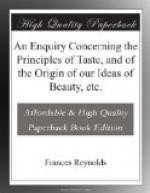And, (to continue my allusion,) as those tints, or blemishes, which obscure the ground, must be discharged to make a perfect white, so must the artist, in creating beauty, discharge the blemishes that tinge and obscure the human form, and which give it the character of mediocrity, till the perfect white, or total absence of defect, or beauty, result.
Common sense seems to be diffusive truth, and common form diffusive beauty; and, as this diffusion is always existing with us, externally and internally, it is no wonder that we should more easily perceive what is in opposition to it, evil, than what is in unison with it, good.
On a line with common form and common sense I place common ease of body and of mind: unfelt health, unfelt good, or that arising to the degree of satisfaction and content; in fine, whatever we call commonly good, and requisite for the well-being of humanity.
Section 2. Beauty and Truth.
I mean that beauty which is demonstrable truth, and that truth which is demonstrable beauty. Exactitude. Completion. The just medium. The satisfactory rest of the mind. Perfection. A point, indeed, in which the mind cannot rest! It must go forward or backward. If the latter, it relapses into the dominion of error; if the former, if assumes the charms of design, or intention. The artist, arrived at the ultimate limit of rules, or demonstrable truth, stands, as it were, between the visible and invisible world; between that of sense and intellect; the common and the uncommon; and his productions will be a conjunction of both. He looks back through all the variety of common nature, and reviews, through the medium of truth and beauty, the various objects it exhibits; and on its spotless ground, i.e. the abstract idea of nature without defects, can only exist in idea, he arranges those objects, objects, so as they may best produce the effects he aims at in his art. He does not attempt to obliterate any character in the common circle of nature; but, following her own oeconomy, he endeavours, by juxtaposition, &c. to make each subservient to each in creating delight, and giving beauty to the whole. But, to descend from the abstract general idea to the particular idea of beauty, or idea of a particular form:
We discard every thing, that is not beauty, to compose beauty; but every thing that is not beauty is not therefore deformity. The wrong we see in each individual we do not call deformity: when it is so, it stands on the limit of the common circle, in opposition to beauty.




